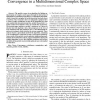Free Online Productivity Tools
i2Speak
i2Symbol
i2OCR
iTex2Img
iWeb2Print
iWeb2Shot
i2Type
iPdf2Split
iPdf2Merge
i2Bopomofo
i2Arabic
i2Style
i2Image
i2PDF
iLatex2Rtf
Sci2ools
TEC
2002
2002
The particle swarm - explosion, stability, and convergence in a multidimensional complex space
Abstract--The particle swarm is an algorithm for finding optimal regions of complex search spaces through the interaction of individuals in a population of particles. Even though the algorithm, which is based on a metaphor of social interaction, has been shown to perform well, researchers have not adequately explained how it works. Further, traditional versions of the algorithm have had some undesirable dynamical properties, notably the particles' velocities needed to be limited in order to control their trajectories. The present paper analyzes a particle's trajectory as it moves in discrete time (the algebraic view), then progresses to the view of it in continuous time (the analytical view). A five-dimensional depiction is developed, which describes the system completely. These analyses lead to a generalized model of the algorithm, containing a set of coefficients to control the system's convergence tendencies. Some results of the particle swarm optimizer, implementing ...
Related Content
| Added | 23 Dec 2010 |
| Updated | 23 Dec 2010 |
| Type | Journal |
| Year | 2002 |
| Where | TEC |
| Authors | Maurice Clerc, James Kennedy |
Comments (0)

